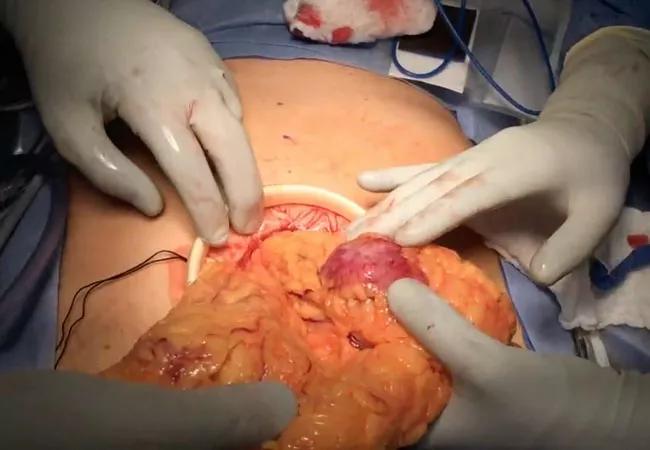Advertisement
Preliminary findings of ongoing feasibility trial

By Anthony Costales, MD and Chad Michener, MD
Advertisement
Cleveland Clinic is a non-profit academic medical center. Advertising on our site helps support our mission. We do not endorse non-Cleveland Clinic products or services. Policy
At the 50th annual meeting of the Society for Gynecologic Oncology, we presented preliminary data from the first 12 patients with advanced ovarian cancer to participate in our investigation of the role of minimally invasive surgery (MIS) in patients undergoing interval debulking following neoadjuvant chemotherapy.
This study evaluates a group of patients who are unable to undergo a primary cytoreduction (i.e., surgery before chemotherapy). These patients first undergo chemotherapy and, if they respond, will undergo an interval cytoreduction (i.e., surgery after chemotherapy).
The standard is to perform these surgeries via a large abdominal incision as the goal is to remove all visible disease. Many surgeons believe this can only be accomplished through a large incision. In many cases, the response to chemotherapy is robust enough that one theoretically could perform an MIS; however, we do not have a way to identify these patients, nor do we know if the survival outcomes would be the same or better.
Our main question is: is there a cohort of patients who respond to neoadjuvant chemotherapy that could undergo a cytoreductive MIS with the same or better survival outcomes?
This pilot study, in particular, attempts to answer two questions:
There are encouraging retrospective studies that have looked at MIS for interval cytoreduction; however, these studies suffer from the fact that they are a highly defined patient population. Since our study opened, we have screened all patients undergoing neoadjuvant therapy for inclusion. If a patient had a partial response to neoadjuvant chemotherapy, they were included, no matter the disease burden.
Advertisement
As a feasibility study, our protocol does not dictate that surgeons continue laparoscopically if they do not feel they will be able to optimally cytoreduce the patient. However, all patients will have 43 intra-abdominal sites evaluated by laparoscopy. At that point, the surgeon will determine if they should continue or convert to a laparotomy. If the surgery continues as an MIS, a hand-assist port is placed peri-umbilically to re-assess all areas in an attempt to mimic a laparotomy to ensure no sites have been missed where disease could be hidden.
In a similar fashion, if a laparotomy is performed, re-assessment follows to identify any sites that the surgeon may not have captured with laparoscopy alone. This is a very key point, as many critics of laparoscopy for ovarian cancer are, rightly so, very wary of whether we will be missing disease by using MIS.
Thus far, of the 12 patients in this preliminary cohort, three were able to undergo a complete MIS interval debulking. As in prior studies, we are seeing that the patients who are able to undergo a MIS interval cytoreduction have a shorter surgery time (189 minutes in MIS compared to 268 minutes in open surgery), shorter length of hospital stay (one day versus four days), less intra-operative blood loss (100 mL versus 500 mL) and report less post-operative pain. These findings correlate with almost all MIS studies when compared to laparotomy and favor the MIS approach.
From even the very first surgery, we noticed that there were some diseased sites, such as the omentum (specifically the peri-splenic area), which we would have missed had we not had the hand-assist port. It is clear, even as we have accrued 21 of a planned accrual of 50 patients, that in any further study of the MIS approach, a hand-assist port for palpation is necessary to ensure complete assessment of the abdominal cavity.
Advertisement
Additionally, there have already been two patients in which a laparoscope was placed and it was determined by the surgeon that an interval cytoreduction, either MIS or laparotomic, would be futile as the patient had minimal response to chemotherapy. This is also very important as we never like to perform surgery on patients if we do not feel the procedure would be beneficial for them. We want to avoid having our patients recover from large abdominal scars when no cytoreduction is performed when a laparoscope may have given us the same information and faster patient recovery.
Although we recognize that this is a very lofty goal, we would like to use the parameters identified in our pilot study for this patient population to perform a randomized study of MIS versus laparotomy to compare oncologic outcomes (i.e., time to return to chemotherapy, progression-free and overall survival). Our hypothesis is that if we can get these patients back to chemotherapy more quickly via the MIS approach because their recovery is quicker, then survival outcomes may be improved.
This study is registered on clinicaltrials.gov (No. NCT03378128), and is currently accruing patients with advanced ovarian cancer who have achieved at least partial response to treatment.
Advertisement
Advertisement

Polygenic risk score could help predict who will develop this aggressive breast cancer

New guidelines offer insight into emerging therapies, dental issues and more

Clinical trial to assess the value of nutritional, physical therapy and social supports prior to preoperative chemotherapy

Research demonstrates improved overall survival for patients receiving comprehensive treatment for breast cancer in addition to radiation or surgical intervention for brain cancer

Platinum-eligible phase 3 trial of enfortumab vedotin and pembrolizumab yields ‘unprecedented data’

Cleveland Clinic Cancer Institute brings multidisciplinary care, precision oncology and clinical research to the United Arab Emirates

Extent of baseline burden impacts progression-free and overall survival

Further study warranted to better understand the clinical implications of these findings